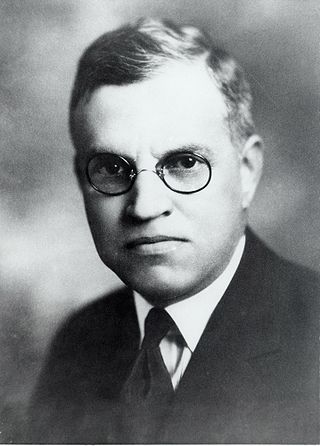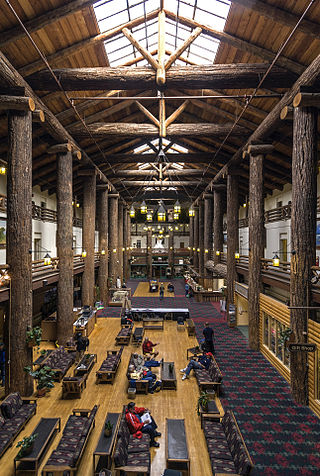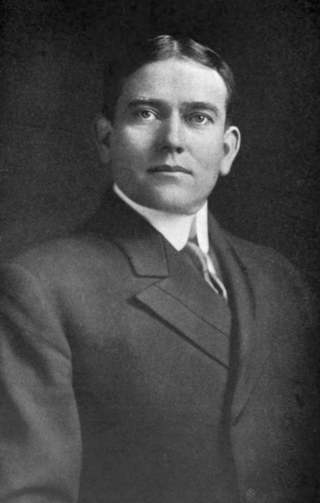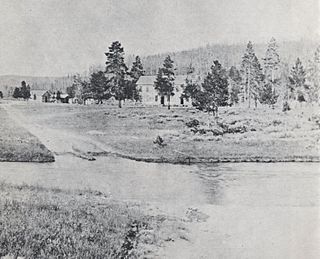
Harry S. Yount was an American Civil War soldier, mountain man, professional hunter and trapper, prospector, wilderness guide and packer, seasonal employee of the United States Department of the Interior, and the first game warden in Yellowstone National Park. He was nicknamed "Rocky Mountain Harry Yount".

William Henry Jackson was an American photographer, Civil War veteran, painter, and an explorer famous for his images of the American West. He was a great-great nephew of Samuel Wilson, the progenitor of America's national symbol Uncle Sam. He was the great-grandfather of cartoonist Bill Griffith, creator of Zippy the Pinhead comics.
This is a broad outline of the history of Montana in the United States.

Fort Yellowstone was a U.S. Army fort, established in 1891 at Mammoth Hot Springs in Yellowstone National Park. Yellowstone was designated in 1872 but the Interior Department was unable to effectively manage the park. Administration was transferred to the War Department in August 1886 and General Philip Sheridan sent a company of cavalry to Mammoth Hot Springs to build a cavalry post. The army originally called the post Camp Sheridan in honor of General Sheridan but the name was changed to Fort Yellowstone in 1891 when construction of the permanent fort commenced. The army administered the park until 1918 when it was transferred to the newly created National Park Service. The facilities of Fort Yellowstone now comprise the Yellowstone National Park headquarters, the Horace Albright Visitor Center and staff accommodations.

Robert Chambers Reamer (1873–1938) was an American architect, most noted for the Old Faithful Inn in Yellowstone National Park. A number of his works are listed on the National Register of Historic Places for their architecture.

Glacier Park Lodge is located just outside the boundaries of Glacier National Park in the village of East Glacier Park, Montana, United States. The lodge was built in 1913 by the Glacier Park Company, a subsidiary of the Great Northern Railway. It was the first of a series of hotels built in and near Glacier National Park by the Great Northern to house visitors brought to the park by the railroad.

Charles Nelson Pray was a United States representative from Montana and a United States district judge of the United States District Court for the District of Montana.

Fort Ellis was a United States Army fort established August 27, 1867, east of present-day Bozeman, Montana. Troops from the fort participated in many major campaigns of the Indian Wars. The fort was closed on August 2, 1886.

Hamilton's Stores were concessioners in Yellowstone National Park from 1915 to 2002. The stores were founded by Winnipeg native Charles Hamilton, who arrived in Yellowstone in 1905, aged 21, to work for the Yellowstone Park Association. The stores provided tourists with food, souvenirs, and sundries at the major attractions along Yellowstone's Grand Loop Road. Several buildings constructed for Hamilton are significant examples of the National Park Service Rustic style of architecture and have assumed prominence as attractions in their own right. Most are included as contributing structures in National Register of Historic Places historic districts.

The following articles relate to the history, geography, geology, flora, fauna, structures and recreation in Yellowstone National Park.

Marshall's Hotel, subsequently known as the Firehole Hotel was the first public accommodations built in the Firehole River geyser basins of Yellowstone National Park and among the earliest tourist hotels in Yellowstone. The first hotel was built in 1880 by George W. Marshall (1838-1917) and his partner John B. Goff and was located just west of confluence of the Firehole River and Nez Perce Creek. A second hotel, the Firehole Hotel, was built in 1884 in partnership with George Graham Henderson very near the present day Nez Perce Picnic area. The hotels operated for eleven years under various ownership ceasing operation in 1891. By 1895, all the structures except a few cabins associated with the two hotels had been razed.

Harry W. Child (1857–1931) was an entrepreneur who managed development and ranching companies in southern Montana. He was most notable as a founder and longtime president of the Yellowstone Park Company, which provided accommodation and transportation to visitors to Yellowstone National Park from 1892 to 1980. Child was, with park superintendent and National Park Service administrator Horace Albright, singularly responsible for the development of the park as a tourist destination and for the construction of much of the park's visitor infrastructure.

The Canyon Hotel was built in Yellowstone National Park in 1910 by the Yellowstone Park Company to accommodate visitors to the area of the Grand Canyon of the Yellowstone and Yellowstone Falls. The hotel was built on a huge scale, with a perimeter measurement of one mile. Situated on a hill to the west of the falls, it dominated the landscape. It had an elegant resort-like air when first built. After World War II it was regarded by the National Park Service as outdated. Suffering from neglect, it was abandoned in the late 1950s and was in the process of demolition when it was destroyed by fire in 1960.

Link & Haire was a prolific architectural firm in Montana, formally established on January 1, 1906. It designed a number of buildings that are listed on the National Register of Historic Places.

Transportation in Montana comprises many different forms of travel. Montana shares a long border with Canada, hence international crossings are prevalent in the northern section of the state; there are 13 road crossings and one rail crossing.
The Trout and Salmonid Collection is a special collection of literature and archives in the Montana State University Library's Merrill G. Burlingame Special Collections Library. The collection is also known as The Bud Lilly Trout and Salmonid Collection, named after Bud Lilly who was instrumental in starting the collection. The approximately 20,000-volume collection, established in 2000, is devoted to preserving literary, scientific, government and media resources related to all aspects of trout and other salmonids. The collection contains materials in many languages and is not restricted by geography. It is considered a world-class collection of international significance relative to the study of trout and salmonids.
Richard Langton Reese was an environmental activist who founded the Greater Yellowstone Coalition and an alpinist who participated in the North Face Grand Teton rescue in 1967.
Pierce Mullen was a professor of history at Montana State University in Bozeman, Montana and was a participant in the Lewis and Clark Trail Heritage Foundation and the Quest for Knowledge Club.
David Edwin Folsom (1839-1918) was a politically active historical figure in the U.S. state of Montana, and notably, the leader of the 1869 expedition of Yellowstone National Park and namesake of Folsom Peak.
Eugene Cole "Gene" Quaw was a Montana musician notable for his outdoor performances at the Canyon Hotel of Yellowstone National Park. At this venue, he would play one of his more well-known pieces, Yellowstone.













